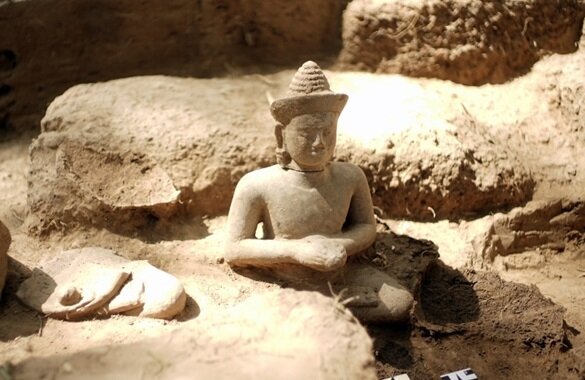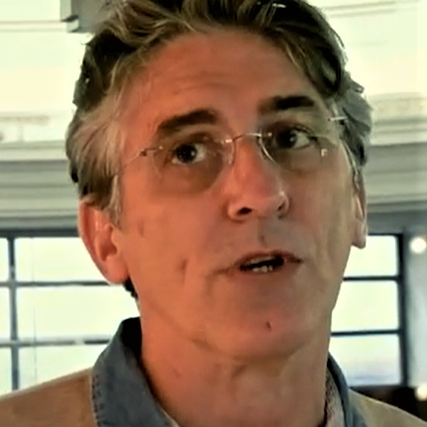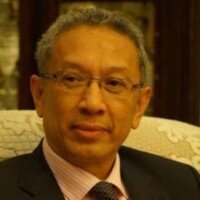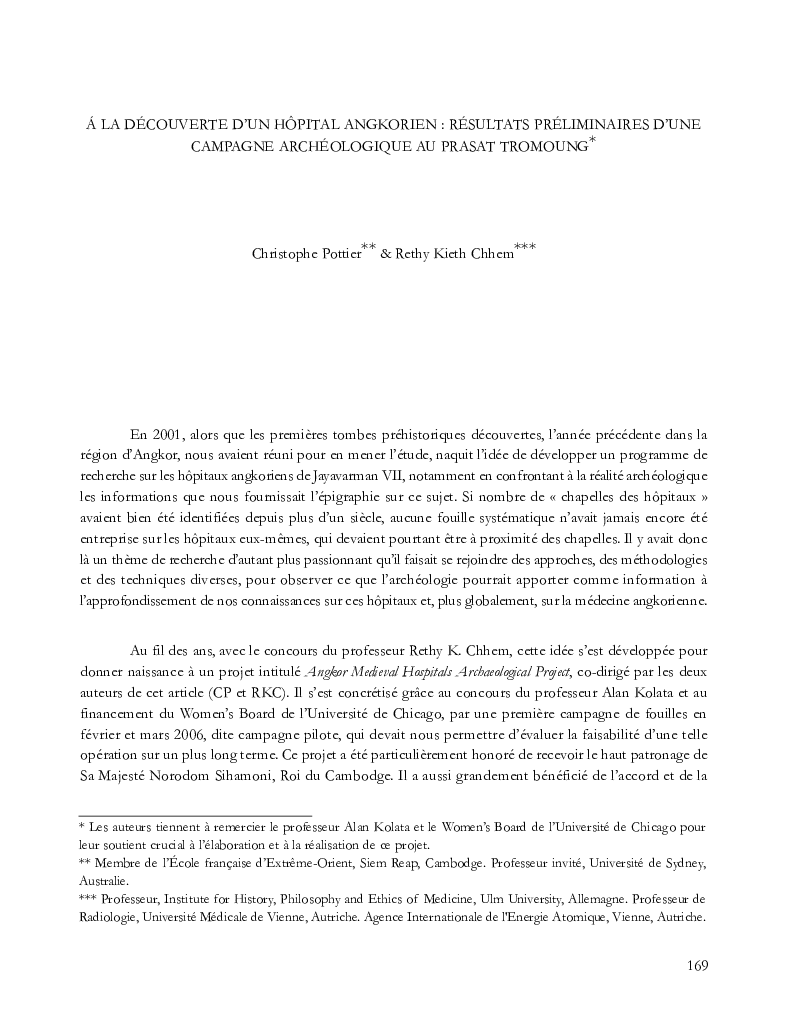A la découverte d'un hôpital angkorien (An Angkorian Hospital)
by Christophe Pottier & Rethy Kieth Chhem
Excavations related to medicine and healthcare in Angkorean times.

- Published
- 2008
- Authors
- Christophe Pottier & Rethy Kieth Chhem
- Pages
- 14
- Language
- French
pdf 375.9 KB
From 2008, four hospitals flanking Angkor Thom have been identified and studied: Prasat Ta Prohm Kel to the south, a nameless structure west of Ta Kev to the east, Prasat Trapeang (or Tonle) Snguot to the north and Prasat Tromung to the west.
The study details the findings related to the hospitals founded during the reign of Jayavarman VII. It is part of the Angkor Medieval Hospitals Archaeological Project, co-chaired by its authors and under the high patronage of HM Norodom Sihamoni (with technical support of APSARA Authority and financial support of the Women’s Board of the University of Chicago).
More about the Angkorian Hospitals through recent archeological findings
The hospitals offered the equivalent of free state healthcare. Each one displaying in a shrine a statue of Bhaisajyaguru, the Buddha of healing and medicine (also called the Medicine Buddha) and followed medical innovations of the time, such as checking a patient’s pulse as part of a diagnostic test and using butter, oil, honey and molasses as medicine.
A 12th-century inscription found in the Say Fong region of Laos — part of the Khmer empire at the time — writes of Jayavarman VII: “He suffered the illnesses of his subjects more than his own; because it is the pain of the public that is the pain of kings rather than their own pain.”
Each hospital — 102 have been identified so far — had about 200 medical workers, including doctors, pharmacists, astrologists and other health professionals.
Yet by the time Jayavarman VII came to the throne, the kingdom already had a long medical tradition. According to Dr Rethy Chhem findings, in the 7th century, there had been a small dynasty of doctors at the Khmer court, one family of doctors spanning four generations. Also during that century, Chinese chronicles mention that a Chinese Buddhist monk was sent to Cambodia for two years to study herbal medicine.
In 2014, a team of archaeologists unearthed fragments of a rare Medicine Buddha carving and a two-meter-tall guardian statue dating back to the 12th century. The excavation near the northern entrance to the former imperial capital of Angkor Thom yielded a veritable treasure trove of ancient artifacts from the grounds of a hospital built by King Jayavarman VII. Alongside the rare statues, the archaeologists also discovered traces of smelting, which might have been for bronze casting, as well as porcelain, roof tiles, and Khmer and Chinese ceramics.
(Sources: Michelle Vachon and Buddhist Door)
Tags: medicine, healthcare, Bhaisajyaguru, Prasat Tromung, Tantric Buddhism, traditional medecine, Jayavarman VII
About the Authors

Christophe Pottier
Christophe Pottier (1966, Mayenne, France) is an archeologist and architect who worked with EFEO mission to Angkor from 1992 till 1999. Previously, he was involved in the restoration of the Khmer temple of Phanom Wan in Thailand, and the indexation of the Angkor related documentation preserved in the EFEO archives in Paris, under the direction of Bruno Dagens.
Assisting the Conservation of Angkor, Christophe Pottier took part in the restoration of the Terrace of The Leprous King (Angkor Thom), a vast effort left unfinished in 1973 when the Khmer Rouges stopped all conservation activities in Angkor. Later on, he Christophe Pottier directed the restoration of the northern staircase at the Terrace of the Elephants, completed in March 1999.
Head of the EFEO Siem Reap center at the start of the 2000s, he contributed to the identification of several hundreds new sites in the area of Angkor, which allowed him to reconsider settlements patterns and densities and to reassess ancient spatial layouts and organisations, which underline and specify the concept of territory in the Angkorian “cities”. This research continues since in the northern area of Angkor.
In addition, Christophe Pottier has headed since 1999 the Cambodian-French Archaeological Mission on the Angkor Region. He is associated since 2000 with the Greater Angkor Project led by Prof. Roland Fletcher, focusing on the spatial and chronological understanding of the decline and fall of Angkor as a center of power. Also, with R.K. Chhem (Western Ontario Univeristy) and A. Kolata (Chicago University), he initiated in 2005 a new Angkor Medieval Hospitals Archaeological Project.

Rethy Kieth Chhem
Dr Rethy Chhem (1952, Phnom Penh) is a medical doctor, biomedical scientist, science diplomat, historian of medicine and educationalist He has been a professor of radiology for 28 years, teaching in Canada, Singapore, Austria and Japan.
Dr Chhem is the Executive Director of the Cambodia Development Resource Institute (CDRI), a leading think-tank in Cambodia and the ASEAN region. In 2018, he was appointed special Health Advisor to Cambodia Prime Minister Samdech Hun Sen. He is also co-leading the Angkor Medieval Hospitals Archaeological Project.
He was the Chairman of the Medical Imaging Department at Western University (Canada) before joining the International Atomic Energy Agency (IAEA) as Director of the Division of Human Health (2008−2014). He has published more than 100 scientific articles, and edited 17 textbooks on radiology, radiology education, paleoradiology, philosophy of medical imaging and radiation sciences, with two on the Fukushima nuclear accident. He was a distinguished visiting professor at the Atomic Bomb Disease Institute, Nagasaki, Hiroshima and Fukushima Medical University.
Narrowly escaping the Khmer Rouge after his parents and two siblings were killed during the civil war, he graduated in France, then obtained a scholarship at University of California, San Francisco, and moved to McGill University in Canada.
His involvement with Angkorian research started in 2000, when French archaeologist Christophe Pottier asked for his expertise while excavating the site of the 8th-century Prey Khmeng temple in Siem Reap province, and was looking for an expert to do a preliminary study on them. Dr Chhem analyzed the skeletons recovered on that site, performing CT scans on them. This contribution triggered his interest in pre-Angkorian and Angkorian medicine.
After joining the excavation of one of the one of the 102 hospitals that King Jayavarman VII (1181−1218) ordered to be built in the late 12th century, Dr Chhem established the existence of a comprehensive, free state healthcare system within the Khmer Empire.

